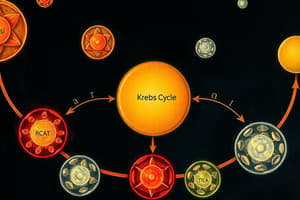Podcast
Questions and Answers
Where does the conversion of pyruvate to acetyl-CoA occur?
Where does the conversion of pyruvate to acetyl-CoA occur?
- Cytoplasm
- Nucleus
- Endoplasmic reticulum
- Mitochondrial matrix (correct)
What is another name for the Citric Acid cycle?
What is another name for the Citric Acid cycle?
- Glycolysis cycle
- TCA cycle (correct)
- Pentose phosphate pathway
- Calvin cycle
Which coenzyme is associated with the enzyme Dihydrolipoyl transacetylase (E2)?
Which coenzyme is associated with the enzyme Dihydrolipoyl transacetylase (E2)?
- FAD and NAD+
- Lipoate and CoA (correct)
- NADH and FADH2
- Thiamine pyrophosphate (TPP)
Where are all the enzymes for the Citric Acid cycle located?
Where are all the enzymes for the Citric Acid cycle located?
How many high energy compounds are produced for each cycle of the Citric Acid cycle?
How many high energy compounds are produced for each cycle of the Citric Acid cycle?
When does puberty typically begin in males?
When does puberty typically begin in males?
What is one of the first signs of puberty in males?
What is one of the first signs of puberty in males?
At what age does menstruation usually occur in females?
At what age does menstruation usually occur in females?
What usually comes after the development of breast buds in females during puberty?
What usually comes after the development of breast buds in females during puberty?
Which of the following is a sign of puberty progression in males?
Which of the following is a sign of puberty progression in males?
What is one of the distinct differences between male and female puberty according to the text?
What is one of the distinct differences between male and female puberty according to the text?
What is the first event in girls during puberty?
What is the first event in girls during puberty?
Which hormone is considered a natural inhibitor of GnRH release?
Which hormone is considered a natural inhibitor of GnRH release?
What age range is typical for menopause to occur?
What age range is typical for menopause to occur?
Which hormone stimulates the secretion of pituitary gonadotropins at the onset of puberty?
Which hormone stimulates the secretion of pituitary gonadotropins at the onset of puberty?
What signifies the end of fertility in women?
What signifies the end of fertility in women?
At what age can puberty be considered pathologically delayed in males?
At what age can puberty be considered pathologically delayed in males?
Flashcards are hidden until you start studying





